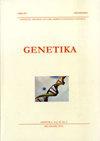Identification of superior wheat genotypes using multiple-trait selection methods based on agronomic characters and grain protein content under rain-fed conditions
4区 农林科学
Q3 Agricultural and Biological Sciences
引用次数: 0
Abstract
Several plant breeding methods have been successfully used to improve genetic resources in many crops such as wheat. However, selection of genotypes based on multiple traits is a complex task for the breeders. The selected genotypes should display high performance in a series of desired traits. The GT-biplot and the multiple selection index have been proposed to identify a superior genotype based on various desired traits. In the present study, thirty wheat genotypes were assessed using randomized complete block design with three replications under rain-fed conditions to evaluate the genotypes by using two different multiple-trait selection methods (i.e. the GT-biplot and the multiple selection index) for agronomic traits and grain protein content. Results indicated that almost the same genotypes (G7, G9 and G16) were selected as superior entries by the both methodologies. Among the superior selected genotypes, the entries G9 (394.6 gr/m2) and G16 (388.9 gr/m2) showed higher grain yield. Furthermore, the entry G7 had the highest level of grain protein (15.91%) in the flour and the entry G18 (40.9%) revealed highest harvest index. In addition, the both methods were appropriate to identify superior wheat genotypes based on the multiple traits but the multiple selection index could be simpler and fast, if proper weights would be selected.基于农艺性状和籽粒蛋白质含量的多性状选择方法在雨养条件下鉴定小麦优良基因型
几种植物育种方法已成功地用于改善许多作物的遗传资源,如小麦。然而,基于多种性状的基因型选择对育种者来说是一项复杂的任务。所选基因型应在一系列所需性状上表现优异。gt -双标图和多重选择指数已被提出,以确定优越的基因型基于各种所需的性状。在旱作条件下,采用3个重复的随机完全区组设计对30个小麦基因型进行了评价,采用两种不同的农艺性状和籽粒蛋白质含量多性状选择方法(即gt双标图法和多选择指数法)对基因型进行了评价。结果表明,G7、G9和G16三种基因型基本一致。在选择的优良基因型中,G9 (394.6 gr/m2)和G16 (388.9 gr/m2)的产量较高。籽粒蛋白含量最高的品种为G7(15.91%),籽粒收获指数最高的品种为G18(40.9%)。此外,这两种方法均适用于基于多个性状的小麦优良基因型鉴定,但如果选择合适的权重,多重选择指数可以更简单、更快速。
本文章由计算机程序翻译,如有差异,请以英文原文为准。
求助全文
约1分钟内获得全文
求助全文
来源期刊

Genetika-Belgrade
AGRONOMY-GENETICS & HEREDITY
CiteScore
1.80
自引率
0.00%
发文量
1
审稿时长
6-12 weeks
期刊介绍:
The GENETIKA is dedicated to genetic studies of all organisms including genetics of microorganisms, plant genetics, animal genetics, human genetics, molecular genetics, genomics, functional genomics, plant and animal breeding, population and evolutionary genetics, mutagenesis and genotoxicology and biotechnology.
 求助内容:
求助内容: 应助结果提醒方式:
应助结果提醒方式:


